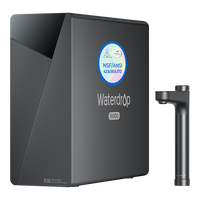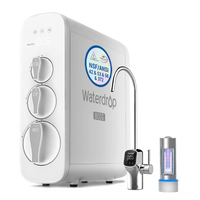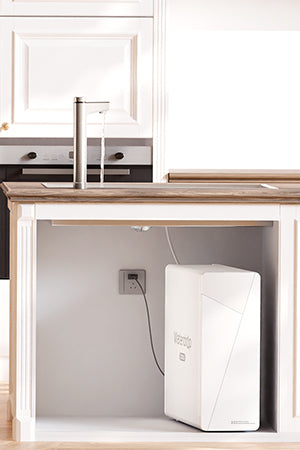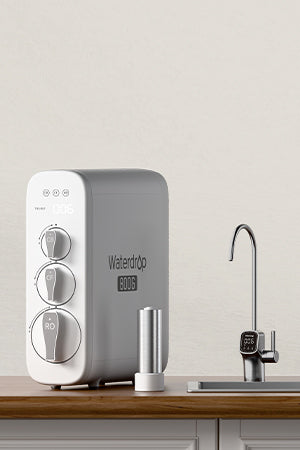The presence of water is a fundamental need for human survival and a vital component of our day-to-day lives. Many different kinds of water may be purchased, but the most famous ones are water that has been boiled and water that has been distilled. Even though each undergoes processes that alter their composition, questions about the differences and similarities continue to be raised.
Within this examination, we investigate the processes of simmering and distillation, illuminating the modifications each method brings about in water. As we embark on this trip, we want to debunk the fallacy that surrounds the question, “Is water that has been boiled the same as water that has been distilled?”
What Is Distilled Water?
Distilled water is the result of a laborious purifying procedure known as
distillation . Through this method, water is heated to generate vapor, which cools and is concentrated into a liquid condition. The ability of distillation to remove minerals and contaminants from water while simultaneously extracting its purest form is its remarkable quality.
RO system, chlorination, and filtration are more methods of cleaning water than distillation. A
Reverse osmosis system is the most effective method for purifying tap water in residential settings that rely on public water sources.
Distillation eliminates contaminants from water, resulting in a remarkably high purity level. It has various uses, including medicinal usage, scientific investigation, and household devices requiring water with little mineral content. Distilled water has unmatched purity, making it suitable for businesses that need precise precision.
What Is Distilled Water’s pH?
It is essential to remember that water does not show a pH of 7 in its natural state, regardless of whether it is distilled, deionized, or sourced from the tap. When carbon dioxide (CO2) is exposed to air, it dissolves in water, forming carbonic acid. As a consequence, the actual pH of the water is often different from 7.
Click to learn more about
What Is Deionized Water .
What Is Boiled Water?
“Boiled tap water” refers to a liquid warmed to its boiling point and cooled without artificial means. Various bacteria and parasites present in untreated water may lead to human sickness. It is advised to consume cooked water since boiling may effectively eliminate any parasites or bacteria in the water.
Humans have used the process of boiling water for thousands of years as a means of removing impurities and pollutants. However, there are uncertainties about the efficacy of boiling tap water as a purification method. Regardless of your location, whether it be a remote area or your own home, boiling water is an effortless but very efficient method to purify it.
What Temperature Does Water Boil?
Reaching 212 degrees Fahrenheit during boiling is critical for eliminating harmful bacteria. Most bacteria may be killed in water over 160 degrees Fahrenheit for thirty minutes.
Governments could publish a
boil water advisory during natural catastrophes to ensure the water’s safety. This preventative technique safeguards public health by neutralizing hazardous microorganisms and eliminating possible pollutants. Boiling water is a simple but effective method to ensure its safety for consumption and minimize potential health risks under inconvenient circumstances.
How Boiled Water Differ from Distilled Water
Procedure for Purification
Boiling is the simple and efficient procedure of raising the water temperature until it reaches its boiling point. Heat treatment efficiently eradicates hazardous bacteria, guaranteeing the safety of the water for consumption. While it addresses microbial concerns, it fails to eliminate minerals and other impurities present in the water.
Distillation is a more sophisticated technique for purification. Water undergoes vaporization when heated, removing minerals and impurities, and then shrinks back into a liquid condition. Using a systematic approach, this process ensures the complete removal of impurities, resulting in water of exceptional purity that is notably free from minerals and other pollutants.
Mineral Composition
The minerals that are found in tap water are retained in boiling water. The mineral composition of the water remains unchanged throughout the boiling process since minerals are not removed. The flavor and overall composition of tap water may be influenced by its mineral concentration.
Conversely, distilled water is devoid of minerals. Water is subjected to distillation to eliminate minerals and other contaminants, resulting in significantly reduced mineral content. Because distilled water is so pure, it may be used in applications without minerals, such as in medical or scientific research.
Impact on Microorganisms
Boiling water is an effective technique for eliminating harmful microorganisms. Boiling water leads to the decomposition of viruses, bacteria, and other harmful microorganisms, making it suitable for human consumption. This method is particularly beneficial when there is a risk of waterborne illnesses.
Distillation is an effective method for eliminating microbes. Contaminants, such as bacteria, are eradicated by converting water into vapor and then condensing it back into a liquid state. In contexts where maintaining microbiological purity is of utmost importance, distilled water ensures that it is entirely devoid of any biological pollutants, establishing it as a reliable choice.
Taste and odor
The flavors of impurities present in the original water source might persist in water that has been boiled. The presence of minerals, chemical substances, and other things in the water’s source might influence the taste characteristics of the water since boiling does not eliminate taste-related constituents.
Distilled water is often characterized by its lack of flavor or odor. Distillation is a procedure that removes volatile chemicals, minerals, and contaminants that might impact the taste and smell.
Deionized water is often devoid of odor or taste, making it an ideal choice for a desired transparent and neutral flavor.
Applications
Water that has been brought to a boil is a standard option for both drinking and cooking. One of its primary benefits is that it eliminates harmful bacteria, which means it may be used to prepare food and beverages. Boiling water is a method that can ensure that water used for everyday purposes is safe.
Distilled water is preferred in specialized environments where great purity is paramount, such as labs and medical-surgical operations. Because it does not contain any minerals or other contaminants, purified water is a reliable solvent that may be used in several scientific research projects and medical devices. It also prevents scale from accumulating in steam irons and other household equipment that utilize water without minerals.
How to Make Distilled Water?
Some individuals may be concerned about how to distill water in their area. It is possible to create distilled water at home; however, it is also available for purchase in retail stores and other retail establishments. Now, let’s have a look at how making purified water at home may be done.
In order to accomplish the task of producing distilled water at home, the following items need to be prepared, the following items are required:
- A large saucepan with a lid
- A smaller bowl
- Ice
- Water
Fill your saucepan halfway with water. Place an empty bowl into your pot. The bowl should maintain a distance from the bottom of the pot, avoiding any contact or submersion. Ideally, it should possess a smaller size than the pot, enabling it to float on the water’s surface. Adjust the heat level of your stove to a moderate setting and heat the water until it reaches its boiling point. Subsequently, invert the lid and place it over the pot, then add ice until it reaches the brim.
When the vapor generated by the boiling water comes into contact with the cold lid, it will undergo condensation. Upon condensation dripping into the receptacle, you will have purified water. Continue distilling until you get the necessary amount of water.
Is Distilled Water Safe to Drink?
Can you drink distilled water? While distilled water is considered safe for consumption, there may be better options for regular usage. Distillation is a process used to eliminate minerals, contaminants, and impurities from water, producing very pure H2O. However, due to their absence, drinking distilled water does not possess the taste and health benefits that minerals such as calcium and magnesium may provide.
Intermittent use of distilled water is generally considered safe. However, long-term reliance on it as your primary source of hydration may be a better course of action. Adopting a well-rounded strategy towards water intake, including various sources of water to ensure the acquisition of essential minerals from one’s diet, is often advisable.














































































